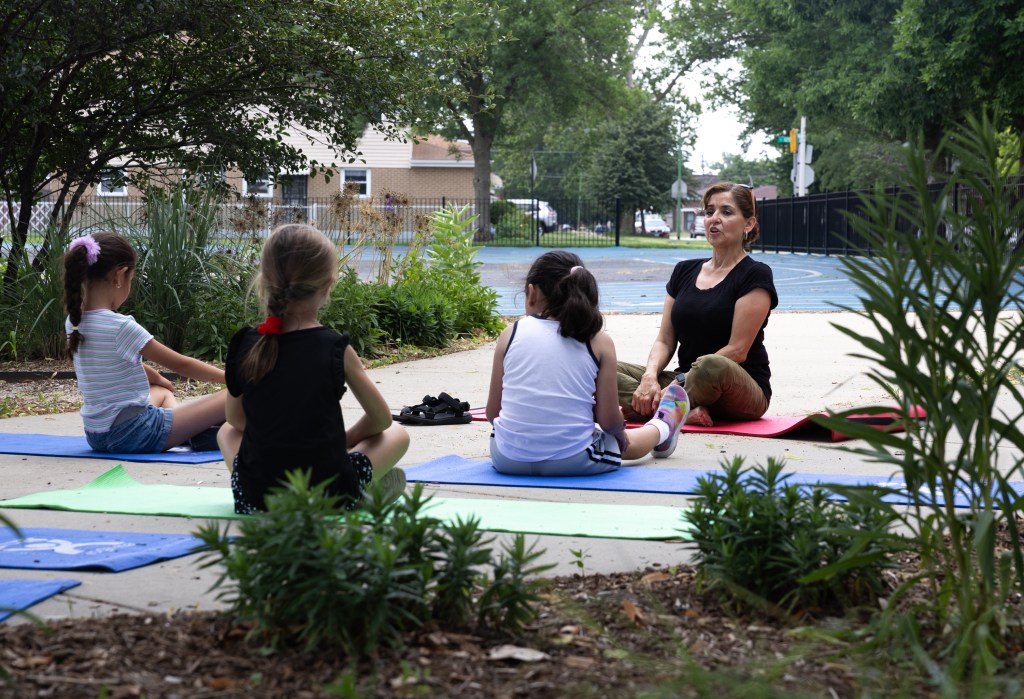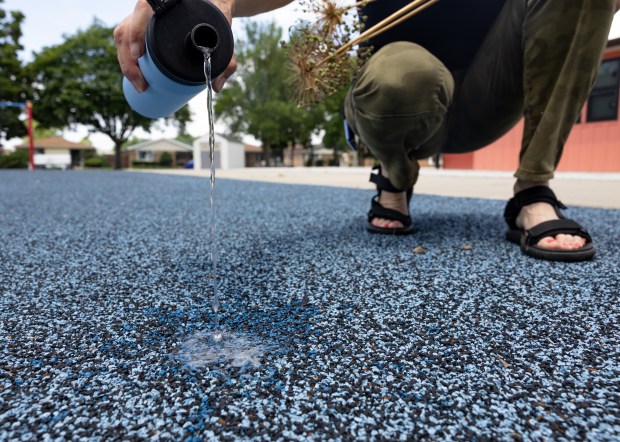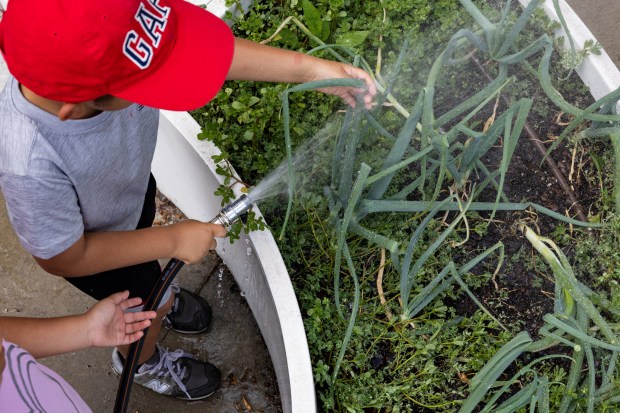Scissors in hand, Hispanic moms in the Hegewisch neighborhood sneak into their children’s schoolyard and snip herbs from the garden to season food and put a twist in their mole.
The verdolaga, or purslane, is part of a variety of vegetables and plants entrusted to the care of students and teachers at Grissom Elementary School.
“The neighbors are like, ‘Oh my God, do you mind?’” said Esperanza Baeza, a bilingual teacher assistant at the school. She tells the parents, “This is our garden. You take whatever you want.”
A decade ago, Grissom’s schoolyard at 12810 S. Escanaba Ave. was not the vibrant space it now is. The tree-lined streets flanking the property stood in stark contrast to 2 acres of dull concrete where the children would play during recess.
Now, the school has a native plant garden brimming with tall grass, flowers and butterflies, a new swing set and additional playground equipment, a basketball court, a running track circling a soccer field and an outdoor class area.
“This was just asphalt. There was nothing,” Baeza said. “It was a really old little piece of swing. Not even a swing, like a slide. That was it.”
The new spaces are also redesigned to address heavy rains in neighborhoods historically vulnerable to serious flooding, particularly on the South and West sides of the city.
In 2014, Chicago-based Healthy Schools Campaign, a national nonprofit that works to ensure schools can provide students with healthy environments, nutritious food, health services and opportunities for physical activity — transformed playgrounds at Grissom and three other schools. Since then, the Space to Grow program has turned 36 barren yards at public schools across Chicago into green community hubs; five more redesign projects are breaking ground this summer.
Claire Marcy, senior vice president of Healthy Schools Campaign, recalls principals from different schools echoing the same concerns: “Look at my outdoor space,” they’d say. “It’s concrete, it’s broken equipment. When it rains, it’s just giant puddles.”
Human-made climate change is only intensifying heavy storms in the Midwest that more easily overwhelm Chicago’s outdated sewer system.
Show Caption
1 of 8
Instructional bilingual teacher assistant Esperanza Baeza teaches a student about purslane in the Garden of Harmony — El Jardín de Harmonía — at Grissom Fine and Performing Arts Elementary School, July 2, 2025. (Hailey Hoffman/for the Chicago Tribune)
At Grissom, permeable surfaces and the water retention system can hold nearly 254,000 gallons at once, and drain quickly between storms.
One of the most recently redesigned schoolyards, which opened at Spencer Technology Academy in Austin this May, can capture more than 625,000 gallons of water each year. Experts hope the redesign will help mitigate heavy rains like those that occurred in July 2023, when most 311 calls for basement flooding came from the West Side neighborhood, a predominantly Black community in an area with high flood risk.
Many of the schoolyards have permeable play surfaces that absorb water into the ground. Some also have underground storage systems — large chambers that slow the release of water into the local sewer system. When the pipes, which carry both stormwater runoff and sewage, are quickly overwhelmed, they can overflow and cause localized flooding issues across the city.
Pavers coil into a spiral design at Grissom’s outdoor classroom stage area, also part of the redesign. But the bricks are not held together by any kind of concrete or plastic edging, which would leave rainwater with nowhere to go.
“If you look at the little stones in between the cracks, that’s what allows the water to seep through,” said Emily Zhang, project manager at Space to Grow.
So far, the program has added over 650,000 square feet — the equivalent of 11 football fields — of permeable surfaces to Chicago’s land area, according to its staff. The actual total might be even higher, however, if grass and other green elements that can also capture rainfall are considered. It all acts like a sponge, Zhang said.
For instance, natural landscaping and design strategies in the redesigns that soak up precipitation include rain and native pollinator gardens or bioswales, which are shallow landscape depressions that hold water, allowing it to seep into the ground.
“No schoolyard looks the same,” Zhang said. “People define green stormwater infrastructure differently, but for us, (they) look like green spaces, or spaces that mimic natural processes of handling water in the water cycle.”
Plants of all kinds grow in the garden, edible and otherwise: onions, radishes, carrots, lettuce, tomatoes, snap peas, milkweed and sunflowers.
“There’s, of course, all the native plants that have deep roots,” Zhang said. “If it were (just a) lawn, then we would see continued flooding issues.”
Scattered along the western edge of the schoolyard are patches of ornamental and native plants and grasses, including purple cornflowers. The first five years, Baeza said, entailed a lot of watering and removing weeds. Every other year, she takes cuttings from some of the herbal plants to create new patches of vegetation.
While Chicago Public Schools has contracts for schoolyard maintenance, students and teachers at the redesigned spaces often participate in daily and regular tasks to care for them, especially the gardens.
“There’s a lot of conversation with the students and the school teams about this: How do we make this your schoolyard that you want to help maintain?” Marcy said. “There’s that everyday stuff about sort of loving and owning the schoolyard … students have really taken ownership over that.”
Inspiring that ownership starts from the beginning of the design process, which involves all students, teachers, administrators and also the broader community. Since the yards remain open after school and on the weekends, they serve as a public park.
“It’s really the only community space on this side of Hegewisch that’s accessible,” said Christine Hurley, Grissom’s principal
Through the collaborative design process, the final elements in each schoolyard respond to needs that might vary across institutions and neighborhoods. Students take surveys, do mapping activities and even create 3D dioramas to bring their visions to life.
“We really value the power of student voices,” Zhang said, “because students and children and young people, in general, are an overlooked population and demographic when it comes to development and making decisions about what happens in their neighborhood. And they’re our future leaders.”
On a recent weekday morning, some students were watering the community garden beds as part of summer school programming. They had just wrapped up a yoga and meditation session.
Once transformed, these play and learning spaces also provide the school and community with a place of relaxation and well-being.
 Google Earth satellite images from April 3, 2013, and May 1, 2015, show a transformation of the schoolyard at Virgil Grissom Elementary School in the Hegewisch neighborhood led by the Space to Grow program of Chicago-based nonprofit Healthy Schools Campaign.
Google Earth satellite images from April 3, 2013, and May 1, 2015, show a transformation of the schoolyard at Virgil Grissom Elementary School in the Hegewisch neighborhood led by the Space to Grow program of Chicago-based nonprofit Healthy Schools Campaign.
Four years after Grissom opened its new schoolyard, researchers from Loyola University and the University of California at Berkeley found the redesigns there and at two of the other schools had increased the use of outdoor space, positive student interactions, greater physical activity, higher teacher satisfaction, and strengthened the relationships between the schools and their communities.
Baeza’s phone rang. It was a student’s mother.
“She’s the one (who) helps me with the garden,” the teacher said. “We have parents that are very dedicated.”
In 2022, the school received an Excellence in Gardening Award from a committee including the University of Illinois Extension, the Shedd Aquarium, Forest Preserves of Cook County and the Chicago Community Gardeners Association.
Baeza had named it el Jardín de la Armonía, or Garden of Harmony.
“Because this is what I want, this is what I envision: Building community, being in a place, a harmonious place — we’re here to be like a family, let the children learn,” she said.







